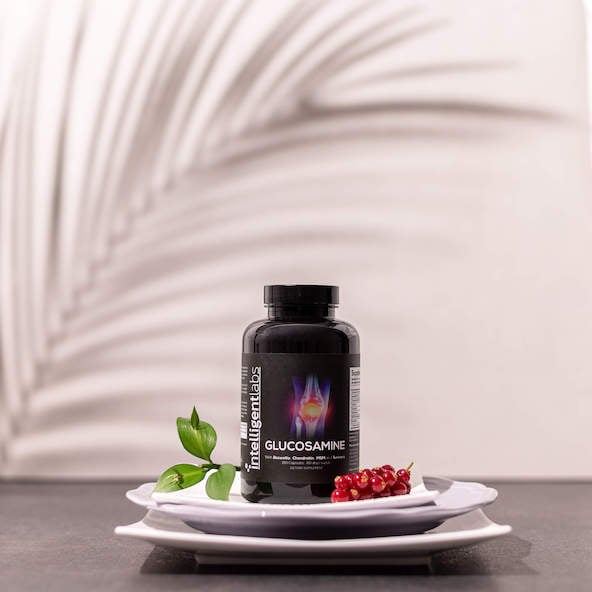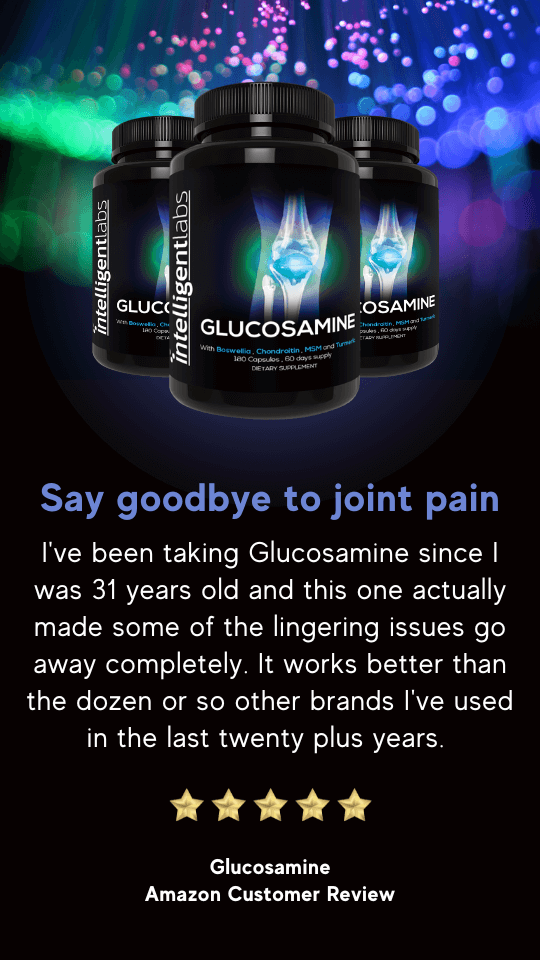Menopause marks the end of a woman’s reproductive years. For many, it’s a new chapter of freedom and self-love. But natural aging and decreased hormone levels cause a number of issues that many women dread. One of them is joint pain.
In this blog post, we’ll look at the different types of joint pain commonly experienced by women in menopause. We’ll also find out if the popular joint supplement Glucosamine can help with menopausal joint pain management.
Table of Contents
What to expect with menopause?
To begin with, you can say goodbye to messy periods and pregnancy. Additionally, uterine fibroids often start regressing in menopause1, which is great for women who have suffered the consequences for years. Not dealing with all these means you’ll have more time to enjoy life!
Consequently, menopausal hormone changes are also responsible for a host of symptoms, such as: 2
- joint pains
- muscle aches
- hot flashes
- mood swings
- vaginal dryness
- decreased libido
- insomnia
What does Glucosamine have to do with menopause and joint pain?

Glucosamine is an amino sugar that’s naturally produced in the human body. It’s an important building block for cartilage, the connective tissue that cushions and protects our joints.
However, the aging process slows down the body’s production of Glucosamine, which can affect both cartilage structure and function, resulting in joint pain.
Fortunately, studies show that taking a high-quality Glucosamine supplement like our Intelligent Labs Glucosamine Complex may help strengthen cartilage and prevent further damage. It may also help reduce inflammation and pain, and improve joint movement!3
Related article: How To Keep Joints Healthy As You Age
What are the types of joint pain in menopause? And can Glucosamine help?
Before we discuss the different types of joint pain, let’s define some terms first.
So, the general medical term for joint pain is arthralgia. More than half of women who reach menopause experience arthralgia.4 It may be due to overuse, injury (e.g. sprain or dislocation), infection, or a symptom of arthritis.
Arthralgia not caused by arthritis may be accompanied by stiffness, joint aches, and reduced movement. This type of joint pain is treatable (maybe even by some joint supplements), depending on what caused the pain.
For arthralgia caused by arthritis, there may be inflammation, swelling, pain, and even structural changes in the joints. The surrounding tissue may also be affected.5 Unfortunately, most arthritic diseases have no cure, but symptoms can be managed.
With that said, for the remainder of this blog post, we will focus on arthralgia caused by arthritis – and whether or not Glucosamine can help. The three most common types of menopausal arthritis are Osteoarthritis, Rheumatoid Arthritis, and Gout.
#1 – Menopause joint pain from Osteoarthritis (OA)
Known as the ‘wear and tear’ disease, osteoarthritis is the most common form of joint pain affecting women in menopause. According to the WHO, over 528 million people have OA, with 60% being women. About 73% of these women are 55 years or older.
It develops when cartilage becomes brittle, the ligaments and tendons stiffen, and bone structure changes. This causes bone to rub on bone, causing friction, stiffness, and pain.6
Symptoms often appear in women 40 or older, with the hands, knees, and hips being the most commonly affected joints.7
Can Glucosamine help women with joint pain from osteoarthritis?

As you will see below, the evidence points to “yes”.
Gregori et al. reviewed 47 studies with over 22,000 combined subjects (mean age was 55-70, and the majority were women). They reported that Glucosamine sulfate helped reduce knee pain and improved joint space narrowing.8
Glucosamine may also help prevent knee osteoarthritis. Runhaar et al.’s study on overweight menopausal women showed that Glucosamine was more effective at knee OA prevention than diet/exercise therapy.9
Also, here’s some good news from women who cannot tolerate the side effects of NSAIDs like Celecoxib. While these drugs do work, they can cause adverse gastrointestinal side effects.
Next to Celecoxib, taking our Glucosamine with Chondroitin is the next best option for knee OA pain relief and function improvement, but with none of the drug’s side effects.10
Quite notably, Glucosamine is also the only one out of several SYSADOAs (symptomatic slow-acting drugs in OA) that helped subjects decrease their use of NSAIDs.11 This may demonstrate Glucosamine’s effectiveness in managing OA.
#2 – Menopause joint pain from Rheumatoid Arthritis (RA)
Rheumatoid arthritis is an autoimmune condition where the body’s immune system attacks the joints. It causes joint pain, severe inflammation, and organ damage. Women with RA are also at increased risk of developing osteoporosis.12
RA affects more than 18 million people worldwide, with 70% of them being women. Over half (55%) of the women are older than 55.13
Can Glucosamine help women with rheumatoid arthritis?
Unfortunately, there isn’t enough evidence to support Glucosamine’s effects on RA. However, Omega-3 fatty acids may be a good alternative.
We did find a small study published in 2007 that gave 1500mg of Glucosamine to RA patients. It seemed to have improved symptoms but had no definitive antirheumatic effect.14
#3 – Menopausal joint pain from Gout
Gout is an inflammatory form of arthritis that is 3-10x more common in men than women. It develops from excessively high uric acid levels in the blood, which then get deposited in the joints. Gout usually affects the big toe, but other joints in the feet, hands, knees, and ankles may be affected too.15
Typically, gout only presents in menopausal women, supporting the theory that female sex hormones (which decline in menopause) may offer protection against the disease.16
Can Glucosamine help women with gout?
Just like RA, there isn’t enough evidence to support Glucosamine’s use on gout. However, one recent study reported that women who took Glucosamine for their osteoarthritis had a lower risk of getting gout. Interestingly, the researchers noted that Glucosamine did not have the same effect in men.17
Related article: Can Vitamin C Help Prevent A Painful Gout Attack?
Conclusion
Glucosamine may help alleviate osteoarthritic joint pain and improve joint function in menopausal women. Unfortunately, women with rheumatoid arthritis and gout need to look elsewhere for relief.
We combine triple-strength Glucosamine with seven other joint relief ingredients in our Intelligent Labs Glucosamine Complex. Our unique formulation lets your body kickstart the healing process and rebuild itself from the inside out so you can enjoy the next chapter of your life!
References:
- Ulin, Mara, et al. “Uterine Fibroids in Menopause and Perimenopause.” Menopause, vol. 27, no. 2, Feb. 2020, pp. 238–242, https://doi.org/10.1097/gme.0000000000001438. ↩︎
- Thorat, Shraddha. “A Community-Based Study on Knowledge Regarding Menopause and Coping Strategies for Menopausal Symptoms in the Field Practice Area of a Medical College.” Bharati Vidyapeeth Medical Journal, vol. 1, no. 4, 9 Mar. 2022, pp. 3–7, https://doi.org/10.56136/bvmj/2020_00005. ↩︎
- Towheed, T E, et al. “Glucosamine Therapy for Treating Osteoarthritis.” The Cochrane Database of Systematic Reviews, no. 2, 2005, p. CD002946, www.ncbi.nlm.nih.gov/pubmed/15846645 ↩︎
- Blumer, Janice. “Arthralgia of Menopause – a Retrospective Review.” British Menopause Society Journal, vol. 29, no. 2, 1 May 2023, pp. 95–97, https://doi.org/10.1177/20533691231172565. ↩︎
- “Arthritis vs. Arthralgia: What’s the Difference?” Healthline, 5 Mar. 2014, www.healthline.com/health/rheumatoid-arthritis/arthralgia. ↩︎
- Shane Anderson, A., and Richard F. Loeser. “Why Is Osteoarthritis an Age-Related Disease?” Best Practice & Research Clinical Rheumatology, vol. 24, no. 1, Feb. 2010, pp. 15–26, https://doi.org/10.1016/j.berh.2009.08.006. ↩︎
- Neogi, Tuhina, and Yuqing Zhang. “Epidemiology of Osteoarthritis.” Rheumatic Disease Clinics of North America, vol. 39, no. 1, Feb. 2013, pp. 1–19, https://doi.org/10.1016/j.rdc.2012.10.004 ↩︎
- Gregori, Dario, et al. “Association of Pharmacological Treatments with Long-Term Pain Control in Patients with Knee Osteoarthritis.” JAMA, vol. 320, no. 24, 25 Dec. 2018, p. 2564, https://doi.org/10.1001/jama.2018.19319. ↩︎
- Runhaar, Jos, et al. “The Role of Diet and Exercise and of Glucosamine Sulfate in the Prevention of Knee Osteoarthritis: Further Results from the PRevention of Knee Osteoarthritis in Overweight Females (PROOF) Study.” Seminars in Arthritis and Rheumatism, vol. 45, no. 4, Feb. 2016, pp. S42–S48, https://doi.org/10.1016/j.semarthrit.2015.11.001. ↩︎
- Zeng, Chao, et al. “Effectiveness and Safety of Glucosamine, Chondroitin, the Two in Combination, or Celecoxib in the Treatment of Osteoarthritis of the Knee.” Scientific Reports, vol. 5, no. 1, 18 Nov. 2015, www.ncbi.nlm.nih.gov/pmc/articles/PMC4649492/ ↩︎
- Rovati, Lucio C., et al. “Effects of Glucosamine Sulfate on the Use of Rescue Non-Steroidal Anti-Inflammatory Drugs in Knee Osteoarthritis: Results from the Pharmaco-Epidemiology of GonArthroSis (PEGASus) Study.” Seminars in Arthritis and Rheumatism, vol. 45, no. 4, Feb. 2016, pp. S34–S41, https://doi.org/10.1016/j.semarthrit.2015.10.009. ↩︎
- Talsania, Mitali, and Robert Hal Scofield. “Menopause and Rheumatic Disease.” Rheumatic Disease Clinics of North America, vol. 43, no. 2, May 2017, pp. 287–302, www.ncbi.nlm.nih.gov/pmc/articles/PMC5385852/ ↩︎
- “Rheumatoid Arthritis.” Www.who.int, 28 June 2023, www.who.int/news-room/fact-sheets/detail/rheumatoid-arthritis. ↩︎
- Nakamura, Hiroshi, et al. “Effects of Glucosamine Administration on Patients with Rheumatoid Arthritis.” Rheumatology International, vol. 27, no. 3, 5 Sept. 2006, pp. 213–218, https://doi.org/10.1007/s00296-006-0197-1. ↩︎
- Singh, Jasvinder A., and Angelo Gaffo. “Gout Epidemiology and Comorbidities.” Seminars in Arthritis and Rheumatism, vol. 50, no. 3, June 2020, pp. S11–S16, https://doi.org/10.1016/j.semarthrit.2020.04.008. ↩︎
- Hak, A. E., et al. “Menopause, Postmenopausal Hormone Use and Risk of Incident Gout.” Annals of the Rheumatic Diseases, vol. 69, no. 7, 9 July 2009, pp. 1305–1309, https://doi.org/10.1136/ard.2009.109884. ↩︎
- Liu, Mengyi, et al. “Associations of Habitual Glucosamine Supplementation with Incident Gout: A Large Population Based Cohort Study.” Biology of Sex Differences, vol. 13, 30 Sept. 2022, p. 52, https://doi.org/10.1186/s13293-022-00461-z. ↩︎




